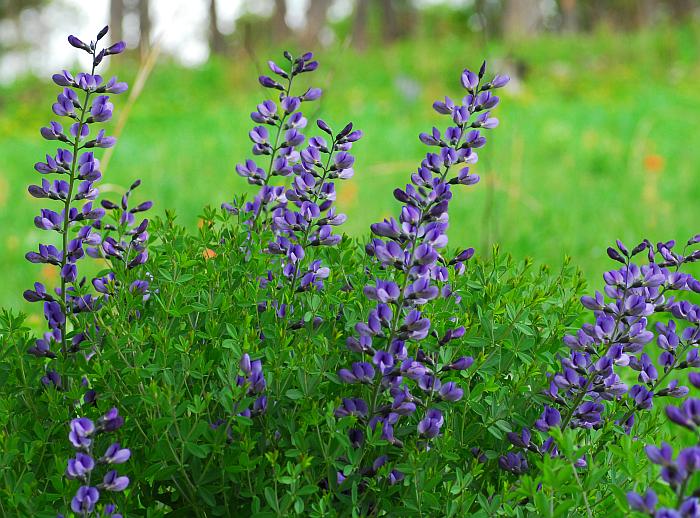Baptisia australis (L.) R. Br.
Blue False Indigo

Native
CC = 8
CW = 5
MOC = 27
© SRTurner
Baptisia australis (L.) R. Br.Blue False Indigo | |
 |
Native CC = 8 CW = 5 MOC = 27 |
© SRTurner |
|
Family - Fabaceae/Faboideae Habit - Perennial forb, deeply rooted with thick, woody rhizomes and woody crown. Plants blackening on drying. Stem - Spreading, ascending, or erect, to 60 cm, with spreading branches, ribbed, glabrous, usually glaucous.
Leaves - Trifoliate, petiolate, stipulate, glabrous. Petioles 1-18 mm long. Stipules 5-20 mm long, lanceolate or rarely ovate, mostly persistent. Leaflets 2-4 cm long, oblanceolate to obovate or occasionally elliptic, rounded to bluntly pointed at the tips.
Inflorescences - Terminal racemes, 10-50 cm long, erect, positioned above the foliage, with relatively few to many flowers, the stalk 3-10 cm long. Bracts leaflike, 6-9 mm long, lanceolate to narrowly ovate, mostly shed early.
Calyces - Calyces with the tube bell-shaped, 4-7 mm long, the lobes triangular, 2-4 mm long, the margins and inner surface finely white-hairy.
Flowers - Corollas papilionaceous, blue or purple (the wings and keel sometimes yellowish-tinged), the banner 14-20 mm long, 12-20 mm wide, the wings 25-30 mm long, 7-9 mm wide, the keel 22-30 mm long, 7-10 mm wide. Stamens slightly upcurved, the filaments 13-25 mm long, the anthers 1.2-1.4 mm long. Ovary 5-7 mm long, glabrous, the style slightly upcurved, 10-12 mm long.
Fruits - Inflated legumes, 3-5 cm long (excluding the stalklike base and beak), 18-25 mm wide, broadly cylindric to ellipsoid, tapered to a stalklike base 4-10 mm long, tapered gradually to the beak, this 15-18 mm long, hairlike only toward the tip, the walls relatively thin and brittle, glabrous and black at maturity. Seeds 4-5 mm long, 2-3 mm wide, greenish brown to brown with warty, resinous dots.
Flowering - April - June. Habitat - Prairies, bluffs, glades, streambanks, pastures, roadsides, freeway margins. Sometimes cultivated. Origin - Native to the U.S. Lookalikes - When flowering, this plant is difficult to mistake for anything else. The fruits have long-tapered beaks, unlike B. alba, which has fruits with abruptly squared-off ends. Other info. - In Missouri this plant is mostly found in the southwestern quadrant of the state, although it is also common in the St. Louis region. Its preponderance along highways and freeways suggest possible sowing by the highway department. The U.S. distribution is confined to a tight band centered in Kansas, Oklahoma, and western Missouri. The plants occurring in Missouri are currently assigned to var. minor. This form is differentiated from var. australis, which is a taller plant occurring farther east. Some hybrids and color variants have also been named. The leaves of this and other species of Baptisia turn black quickly upon being picked. The seeds inside the inflated fruit rattle nicely if the pod is dry. The sound has spooked many a scout into thinking rattlesnakes were nearby. Photographs taken near Gray Summit, 4-8-2012; at Klondike County Park, St. Charles County, MO, 5-15-2014; Shaw Nature Reserve, Franklin County, MO, 4-22-2012, and at Valley View Glades Natural Area, Jefferson County, MO, 5-24-2021 (SRTurner). |